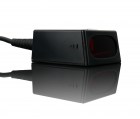For many people, the code reader has only one simple use - it reads a string of characters contained in the code and then sends it to a computer, where it is stored in a text program or a target warehouse management or accounting application.
On the other hand, a large number of customers pay attention to additional symbols or functions that the reader may pass before, after or even in the middle of the code. The characters before the code are called prefixes. By default, virtually none of the readers has a prefix set, so each user commencing work can set it himself, if he has such a need. The characters after the code are called suffixes. Usually, the default setting for readers is to add the enter key and move to the next line, but not all readers have this feature by default and you need to manually activate it.
What can be included in such prefixes? First of all, two groups can be distinguished - the first of them are visible characters, which can be organoleptically perceived that they are added to the sequence of characters in a given code. They can be both uppercase and lowercase alphabets and numbers, as well as characters like @, #, $ and others. The second group, however, are hidden characters, the operation of which may not be visible in ordinary text fields, but may launch additional windows in specific programs. Such signs will be, among others function keys (F10, F11, etc.) and not every reader has such advanced programming functions.
The above-mentioned options for programming characters inside the code are also gaining more and more popularity. It consists in setting after what number of characters is to insert a break, and then defining what the given break should contain. This is a very helpful tool when, for example, part of the code is to be in a different place than the rest of the string.















